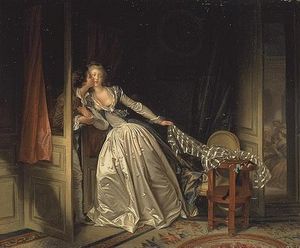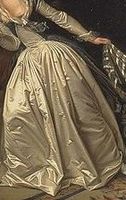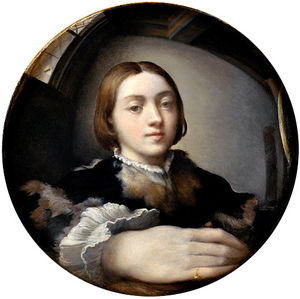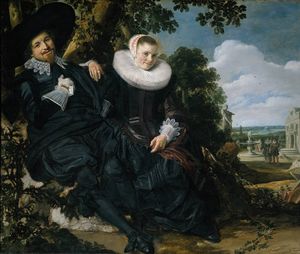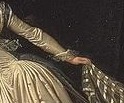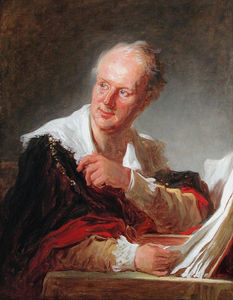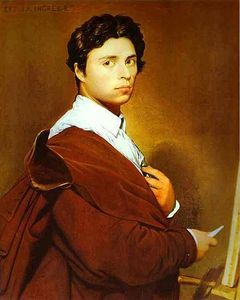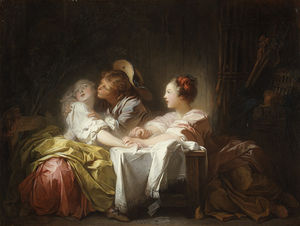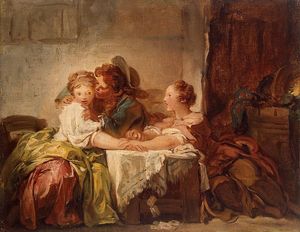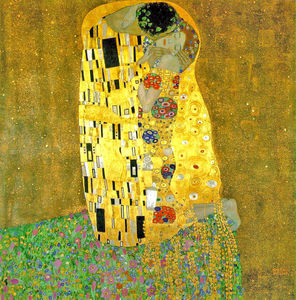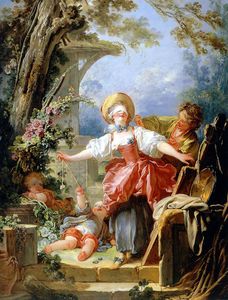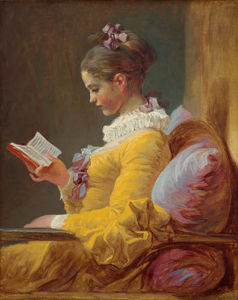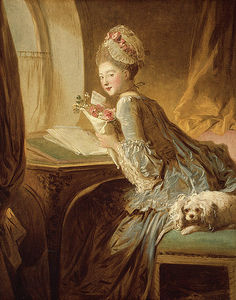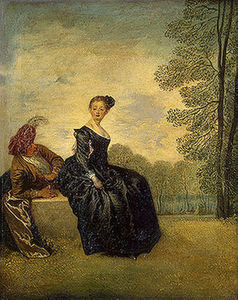The Stolen Kiss
- Date of Creation:
- 1788
- Height (cm):
- 45.00
- Length (cm):
- 55.00
- Medium:
- Oil
- Support:
- Canvas
- Subject:
- Scenery
- Art Movement:
- Rococo
- Created by:
- Current Location:
- Saint Petersburg, Russian Federation
- Displayed at:
- State Hermitage Museum
- Owner:
- State Hermitage Museum
- The Stolen Kiss Page's Content
- Story / Theme
- Inspirations for the Work
- Analysis
- Critical Reception
- Related Paintings
- Artist
- Art Period
- Bibliography
The Stolen Kiss Story / Theme
The Stolen Kiss explores the theme of secretive romance and passionate moments grabbed in a fleeting moment. The painting captures a perfectly frozen moment in time; two lovers caught by the spectator in the act of stealing a furtive kiss while no-one else is looking.
The young maiden is coquettish, leaning in for the kiss while at the same time looking away back towards the other members of the party in the next room over.
The action is stilted, the figures posed in what almost seems to be a caricature of a passionate embrace. In keeping with the frivolity of Rococo style, the young lady's dress is painted with extraordinary attention to detail. The decoration and fashion becomes almost a third character in the scene.
This type of semi-erotic theme was quite popular in the heady days before the French Revolution, particularly with the French aristocracy who slouched fashionably around the halls of Versailles digging up romantic follies and gossip fodder of their own. Fragonard was the favored genius of this genre.
One can almost see in the sly look of the maiden's eyes the knowledge of the coming storm, knowing that the decadence couldn't last; and in this way The Stolen Kiss stands as a historical artifact, transcending the bounds of mere genre eroticism.
The Stolen Kiss Inspirations for the Work
This painting, typical of the later works of Jean-Honoré Fragonard, draws strongly from several sources. Obviously the subject matter is taken from the erotic themes popular of the day, with a young maiden lured away for a quick tryst in the hall during a society gathering. The end result draws from several stylistic sources.
Mannerism:
The long lines of the maiden's figure, stiff pose and tapered fingers are typical of Mannerist influences, such as Parmigianino, Rosso Fiorentino and Jacopo Pontormo.
Fragonard had been an admirer in his younger days of this particular style, and this influence carried over into his later career and is apparent by The Stolen Kiss.
Dutch Masters:
Dutch artists such as Rubens and Hals provided inspiration for the glossy finish of the painting, as well as the blended brushstrokes and precise attention to detail. This detail is particularly evident in the carpeting and fabrics of the portrait.
Birth of Neoclassicism:
The French Revolution caused a return to idealist depictions of human figures, and though by no means a mythological or classical composition, The Stolen Kiss is a far cry from the earlier whimsical style of Fragonard. The influence of new painters such as Jacques-Louis David is made apparent in the clean lines and starker tone of the painting.
The Stolen Kiss Analysis
The Stolen Kiss is a watershed moment in Fragonard's career, combining his past and future influences after the crushing blow of the French Revolution. This painting combines the playfully erotic subject matter of his earlier works with a newfound sobriety of composition and attention to detail that looks forward to the advent of Neoclassicism. For Fragonard was nothing if not attuned to fashion.
Composition:
There is a definite flow to the figures in The Stolen Kiss. The woman is the focus, her facial expression emphasizing the clandestine nature of the action.
The eye naturally starts at her face and creamy bust and wanders down the soft elegant curve of her arm, leading to the fabric, and like a waterslide, splashing down into the pool of the rest of the party hidden in the shadows of the open door.
Color palette:
The colors utilized fall within the typical Rococo palette, belonging to the family of pastel fabrics, creamy skin tones and rich golden tones to the wood that defines the background.
The woman's gown is a soft pastel blue that accentuates her eyes and gives her a willowy and delicate grace. Her skin is porcelain and the color scheme lends a rich softness to the proceedings.
Use of light:
There is a stark contrast between the light and dark within this painting. As the main focus of the composition, the young maiden is illuminated, the voluminous satin folds of her gown and her fair, glowing skin highlighted by a softly direct light.
The shadows of the background emphasize the illicit affair that is going on, separating the lovers from the rest of the party to the right of the painting, dimly visible through the open door.
Mood elicited:
Through a combination of the techniques outlined above, Fragonard has created a hushed, intimate portrait of a drawing room tryst, the cool colors giving a nocturnal glow to the scene where the lovers are caught off-guard in a moment of stolen passion.
Brushstroke:
In this later work Fragonard employed a more precise brushstroke than in his earlier, looser pieces. The brushstroke still retains its fluidity however, evident in the elegant curves of the woman's arm and the delicate drapery of the fabric.
The newfound attention to detail can most likely be attributed to the popularity at the time of the Dutch Masters such as Rubens and Hals.
The Stolen Kiss Critical Reception
Contemporary Reception:
While Fragonard received no shortage of commissions from the aristocracy in Paris, the leading thinkers of the time had more unkind reactions to his work.
His frothier works that catered to the erotic tastes of the elite brought Fragonard harsh criticism from philosophers such as Denis Diderot, one of the foremost designers of the French Enlightenment. Diderot charged the artist with frivolity and suggested that he have "a little more self-respect. "
Posthumous Reception:
Post-revolution, there was no room for the frivolity and shallow subject matter of the Rococo artists, Fragonard's The Stolen Kiss included. A great deal of his client base died during the Terror in Paris, and the artist was forgotten for a while.
The style of his painting was forsaken in favor of cleaner lines, moral severity, and classical subject matter of the Neoclassicists, such as Ingres.
Modern Day Reception:
Today the work of Fragonard has been rediscovered by a generation that possesses a similar taste for frivolity, particularly in the world of high fashion which thrives on the frills and moods set by portraits such as The Stolen Kiss. In fact this particular painting is one of the most popular in terms of reproductions and modern home decorations.
The Stolen Kiss Related Paintings
The Stolen Kiss Artist
A genre painting of a moment of brief illicit passion in the hallway of a plush abode, The Stolen Kiss is a typical Fragonard work: sumptuous, erotic, and lighthearted.
Reputedly one of the most prolific painters of the 18th century, if not of all time, Fragonard had a feverish output of varied subject matter. From portraits to scenes of pastoral, erotic, or domestic appeal he covered a wide range of themes. Fragonard's work is easily recognizable due to the lightness and frivolity of the subject matter, the deft touch of the brushwork, and the soft, carefree lighting schemes.
As charming and witty as his paintings, Fragonard was one of the most prolific artists of his time, producing more than 550 works during his career. Serving as an apprentice to Chardin and Boucher, two of the premier Rococo artists he later won the Prix de Rome and attended the French Academy.
Fragonard's work came with a high pedigree and prestige and as one of the last artists of the Rococo; his name is almost synonymous with this frivolous, erotic, and decadent movement.
Today Fragonard is thought of as a relic of a time past, a testament to a somewhat innocent time period before the French Revolution wiped out the aristocracy and ushered in a new era of democracy.
The Rococo has not weathered the test of time too well as far as being heralded as an artistic period that produced anything of importance. Rococo artists lived in their own bubble, much like the noble class of the day, and now their work is regarded more out of historical interest rather than artistic.
The Stolen Kiss Art Period
Fragonard was a product of the later stages of the Rococo era, a time characterized by hedonistic freedom and a pursuit of all things aesthetically pleasing. The Rococo era originated from the French decorative style Racaille meaning 'decorative shell and rock work'.
Rococo was created by and for the rich of France. They wanted works that reinforced their wealth and pleasure in all beauty and splendor, as artists recreated scenes of arcadia. The Palace of Versailles was the ideal in decadent Rococo art and architecture, informed by ideas of the French Enlightenment.
A master of the domestic scene, the pastoral landscape and tongue-in-cheek eroticism of the boudoir painting, Fragonard had his share of admirers and wielded a strong influence over future masters of the art world, particularly the Impressionists.
Impressionism as a movement bears similarities to the Rococo in its emphasis on fleeting moments of beauty, sudden impressions, and pleasure.
Although for a time after the Revolution Fragonard disappeared from the history of art, his wittily airy style cropped up again years later with a new legion of imitators and by the end of the 19th century there was a rediscovery of Fragonard and other Rococo artists, such as Watteau.
The Stolen Kiss Bibliography
For further information about Jean-Honoré Fragonard's contribution to the Rococo movement, please choose from the following recommended sources.
• Ashton, D. Fragonard in the Universe of Painting. Prentice Hall & IBD, 1988
• Cuzin, Jean-Pierre. Fragonard: Life and Work. Harry N. Abrams, Inc. , 1988
• Dupuy-Vachey, Marie-Anne. Fragonard. Pierre Terrail, 2006
• Molotiu, Andrei. Fragonard's Allegories of Love. J Paul Getty Trust Publications, 2008
• Massengale, Jean Montague. Fragonard (Masters of Art). Harry N. Abrams, Inc. , 1998
• Rosenberg, Pierre. Fragonard: Metropolitan Museum of Art. Harry N. Abrams, Inc. , 1988
• Rosenberg, Pierre. From Drawing to Painting: Poussin, Watteau, Fragonard, David, and Ingres (A. W. Mellon Lectures in the Fine Arts). Princeton University Press, 2000
• Sheriff, Mary D. Fragonard: Art and Eroticism. University of Chicago Press; 2nd edition, 1990

